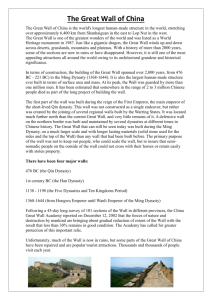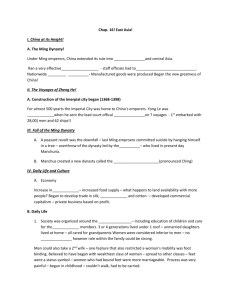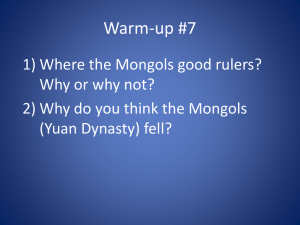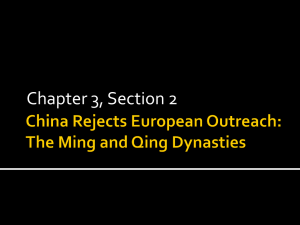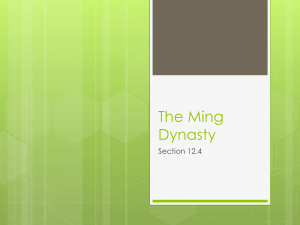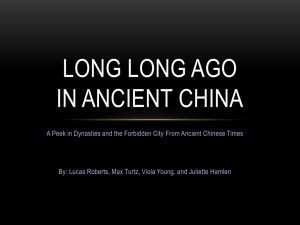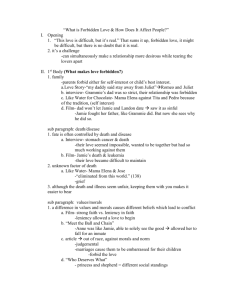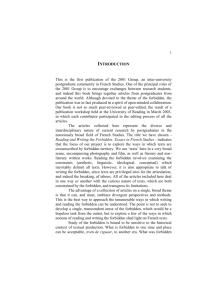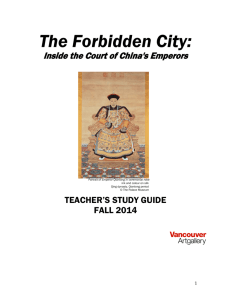The Forbidden City
advertisement
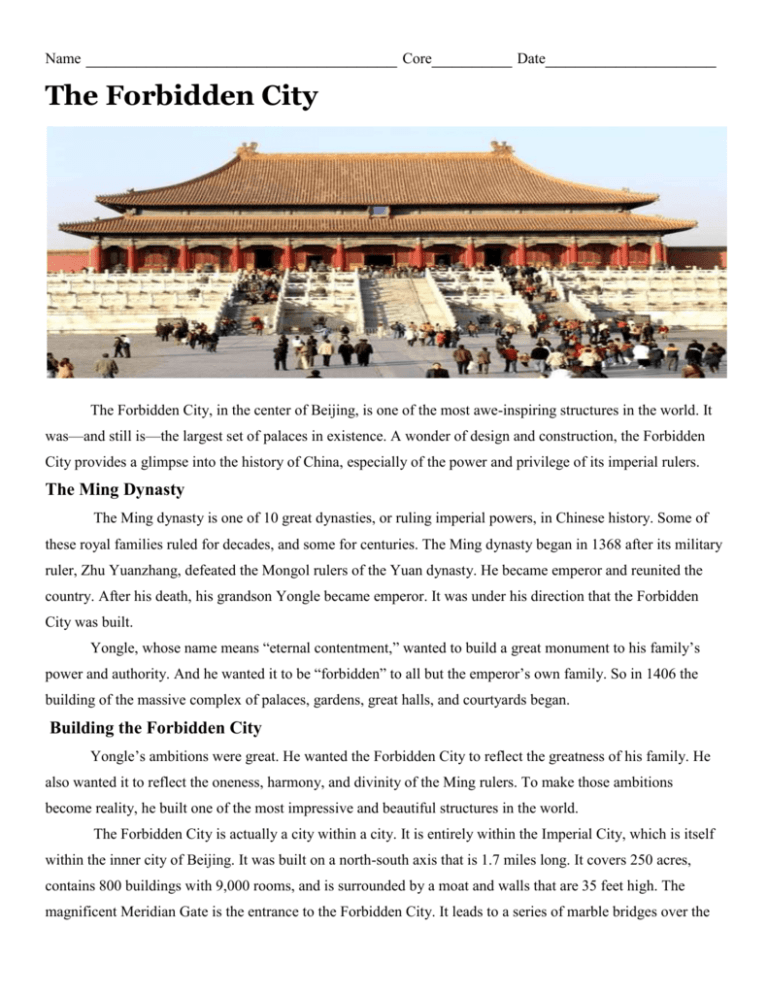
Name _______________________________ Core________ Date_________________ The Forbidden City The Forbidden City, in the center of Beijing, is one of the most awe-inspiring structures in the world. It was—and still is—the largest set of palaces in existence. A wonder of design and construction, the Forbidden City provides a glimpse into the history of China, especially of the power and privilege of its imperial rulers. The Ming Dynasty The Ming dynasty is one of 10 great dynasties, or ruling imperial powers, in Chinese history. Some of these royal families ruled for decades, and some for centuries. The Ming dynasty began in 1368 after its military ruler, Zhu Yuanzhang, defeated the Mongol rulers of the Yuan dynasty. He became emperor and reunited the country. After his death, his grandson Yongle became emperor. It was under his direction that the Forbidden City was built. Yongle, whose name means “eternal contentment,” wanted to build a great monument to his family’s power and authority. And he wanted it to be “forbidden” to all but the emperor’s own family. So in 1406 the building of the massive complex of palaces, gardens, great halls, and courtyards began. Building the Forbidden City Yongle’s ambitions were great. He wanted the Forbidden City to reflect the greatness of his family. He also wanted it to reflect the oneness, harmony, and divinity of the Ming rulers. To make those ambitions become reality, he built one of the most impressive and beautiful structures in the world. The Forbidden City is actually a city within a city. It is entirely within the Imperial City, which is itself within the inner city of Beijing. It was built on a north-south axis that is 1.7 miles long. It covers 250 acres, contains 800 buildings with 9,000 rooms, and is surrounded by a moat and walls that are 35 feet high. The magnificent Meridian Gate is the entrance to the Forbidden City. It leads to a series of marble bridges over the moat. These lead to another gate, the Gate of Supreme Harmony. That leads to the Outer Court, which contains three great halls where the emperor met with his advisors. These three buildings were for government business. They are called the Hall of Supreme Harmony, the Hall of Complete Harmony, and the Hall of Preserving Harmony. Behind the Outer Court lies the Inner Court. It was the home of the emperor, his family, and their slaves and servants. It contains palaces, courtyards, living quarters, gardens, and pavilions. These buildings were meant to reflect the higher status of the imperial family. The construction of the Forbidden City was a huge project. One million workers labored for 14 years to build the complex. Hundreds of artists created sculptures, statues, paintings, and carvings to decorate it. Many of the buildings have roofs covered in golden tiles as well as walls painted dark red, the Ming court colors. Massive lion statues, symbols of imperial power, guard the many entrances to the buildings. Everywhere, the art and decoration was created to enhance the importance and power of the imperial rulers. When the Forbidden City was finally finished in 1420, it became the home of the Ming ruler and his family. No one else was ever allowed into the Inner Court. And only the emperor’s high-ranking advisors were allowed in the Outer Court. It was centuries before the ordinary people of China, and the world, ever saw inside the magnificent complex. After the Ming Dynasty The Ming dynasty lasted for nearly a century, from 1368 to 1644. It ended when hostile invaders from the north, the Manchu, defeated the Ming in battle. The Manchu took over China and established their own dynasty, the Qing. The Qing remained in power for nearly 300 years. This was the last Chinese dynasty, and it ruled China until driven from power in 1911. The Forbidden City remained the private residences of the imperial families of China throughout the Qing dynasty. When it was finally opened to the general public in 1925, the rest of the world learned of the treasures of the Forbidden City. Although it is no longer “forbidden,” the Imperial Palace, as it is now known, still holds great importance to the Chinese people. For example, in 1949, former Chinese communist leader Mao Zedong announced the founding of the People’s Republic of China at its Gate of Heavenly Peace. Because of its great beauty and importance to Chinese history, the Imperial Palace was named a World Heritage Site in 1987. These sites are named by the United Nations Educational, Scientific, and Cultural Organization (UNESCO). World Heritage Sites are places with important cultural or natural history that should be preserved. Today, the Forbidden City is one of the most popular tourist sites in the world. Its museum contains priceless art and artifacts, including paintings, statues, and carvings, as well as millions of manuscripts and documents. It is the lasting symbol of the 24 emperors who made this vast complex of royal buildings their home for over 500 years. World Heritage Sites are places with important cultural or natural history that should be preserved. Today, the Forbidden City is one of the most popular tourist sites in the world. Its museum contains priceless art and artifacts, including paintings, statues, and carvings, as well as millions of manuscripts and documents. It is the lasting symbol of the 24 emperors who made this vast complex of royal buildings their home for over 500 years. __________________________________________________________________________________________ Question (8 points) 1. Describe the structure of the Forbidden City and why it was built. Provide details and evidence from the reading passage to support your answer.


